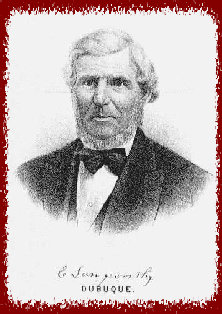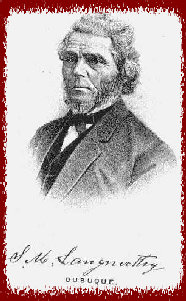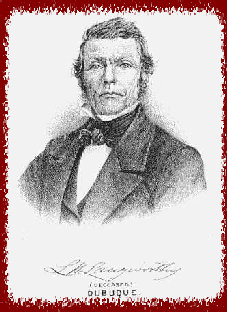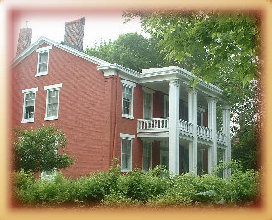




Traveling by wagon, they reached "Wood's Woodyard" (modern-day Quincy), pop. 40,000. Here, Solon bid farewell to his brothers and sisters as they boarded a steamboat headed for James and Orrin's mining town. Without delay, Solon took charge of the wagon team and ascended the bluff, becoming the first to do so.
Solon returned to Diamond Grove, now the eldest brother still residing there. With the assistancee of his younger brother, Lucien and another man, he managed the farm consisting of more than one hundred acres. At the time, corn was sold for only 10 cents and wheat 37 cents per bushel; other products being proportionately low. Remoteness from markets compelled the exchange of farm products for dry goods, groceries, and other necessary articles, which were excessively high priced in comparison. 1,000 bushels of corn were delivered at Jacksonville, two and one-half miles away, in exchange for a horse, valued at $100.
Soon after her arrival in the lead mining country, Mary Ann fulfilled her promise to marry Orrin Smith, Maria sharing their home. The marriage was followed by those of Eliza, marrying William Maclay, and Laura, marrying Jacob D. Williams, both in 1827. Meanwhile, Lucius and Edward settled in a cabin in Coon Branch, also near Hazel Green, and began mining. In April 1828, Solon left Diamond Grove with Horace McCartney and headed for Galena, Ill.
Inhabitants were scarce between the two towns. Although Natives had sold these lands, many still remained, slowing White settlement. Solon and Horace had traveled a short distance west of the Illinois River when they met a party of drovers en route for the mines. They were strongly advised not to journey alone, and joined the drovers for six or seven days. Once they were within twenty miles of Rock River, their provisions nearly exhausted, they left the slow-traveling drovers to press on more quickly. As they approached the river, however, a large body of mounted Indians surrounded them.
Two chiefs, communicating through gestures and broken mutterings, inquired as to the business and destination of the two travelers, and examined their equipment. Next, they signaled the voyagers to follow them. In minutes, the entire party was on the banks of the Rock River. Solon and Horace asked the chiefs for the use of their canoes to cross the river, but were denied. Young natives sportively wrestled with the travelers before the men continued across the river by horse. When they reached Council Hill, the men separated, and Solon set out for Buncomb to meet his brother James. The following day, Solon and James continued to the mining cabin on Coon Branch where Lucius and Edward lived. For the first time in several years, the four brothers were reunited.
Orrin Smith joined the brothers and invited Solon to his residence on the Platte (British Hollow). Here he visited his two sisters before returning to Coon Branch, where he resided that summer with Lucius and Edward. As a miner, the season proved fortunate, enabling Solon to revisit Diamond Grove in November 1828, accompanied by James Meredith. The next three years were devoted to labor upon the farm, which sold in 1831, the remaining family members (all siblings now totalling 21) moving to St. Charles, Mo.
Solon now found employment with a neighboring farmer. Becoming dissatisfied with that business in July 1832, he enlisted in Co. A, United States Ranging Service, commanded by Capt. Nathaniel Boone, grandson of the famous Daniel Boone. He reported to Gen. Winfield Scott at Rock Island August 20, 1832, whereafter the company encamped below the garrison. In the weeks following, cholera made its appearance in the garrison, creating great alarm. The company obtained permission to make a fresh camp south of the Rock River, just six miles away. Twelve of its members died of the malady, a slight mortality compared with that of the garrison.
September 1, Gen. Dodge dispatched two of his Aids-de-camp, H. L. Massey and James L. Langworthy, announcing to Gen. Scott the capture of Black Hawk at the battle of Bad Axe. Solon was at Rock Island when the treaty was made terminating the war. The company, being enlisted for a year's service, was then ordered to Fort Gibson, on the Arkansas River, arriving in early January 1833. The following spring, they were sent westward to protect the Santa Fe trade, a service for which the company had been originally designed. Late that summer, the company marched to Fort Gibson and was disbanded. Solon, along with Ezra Overall, and William H. and Jesse Moureing, returned to their Missouri homes. Upon reaching St. Charles, Solon discovered that his brother-in-law, Mr. Williams, had died of cholera, and he remained with his sister during the winter to help her settle the estate.
In the meantime, brother Edward constructed the first house in the future state of Iowa (Sept. 1832) before he and brother James were driven out of the area in November by soldiers from Prairie du Chien, WI. It was the soldiers' responsibility to keep whites east of the Mississippi for treaty purposes. The brothers returned the following April, and Edward eventually built many homes and stores. James helped construct the first school house in Iowa (1833) before hiring Lyman Dillon to construct the military road between Dubuque and Iowa City. The modern-day towns of Solon and Langworthy In 1836, James built the second brick home in Dubuque, on the corner of Iowa and Twelfth streets.
In the spring of 1834, Solon left for St. Louis on the steamer Olive Branch, headed for Galena. Here he met his sister Maria, who had become the wife of Capt. Smith Harris. Traveling on the captain's boat, the Jo Daviess, Solon visited Dubuque the following day. Here he became the guest of his three brothers in their mining cabin in Langworthy Hollow. He started working for his brothers hauling rails for fencing a farm at the heart of the city. In June, Solon became the first to plow land in Iowa, breaking up sixty acres. When the farm work was finished, he was ready to begin his career in mining.
In the fall of 1834, he purchased a large mineral lot on the Maquoketa. His brother Lucius worked along side of him and together struck a descent prospect after just two weeks. They built a cabin on the site, and Lucius returned to Dubuque while Solon lived in the cabin. He hired two men and continued mining there for a year-and-a-half. In the autumn of 1835, he bought a second potential mining spot on the Ewing Range. After blasting about a month, he discovered a large cave filled with shining ore, inspiring him toward further mining endeavors.
In the spring of 1836, Solon entered into a partnership with Orrin Smith. Together they mined places on Fever River and Coon Branch, purchasing a claim of 2,000 pounds on Coon Branch for $800, and exhausting it in one day. After deserting the spot, Orrin Smith left for Cincinnati while Solon met four Jemison brothers from Missouri just days later, buying their lot, cabin, tools, and lead, which was already on the surface. Paying just $2,500, he acquired between sixty and seventy thousand pounds of mineral already extracted. After two months of further excavation, he was able to sell over three hundred and fifty thousand pounds of mineral. He had hired four men to assist in the operation, but after all expenses still profited $4,000, which he split with his partner, Orrin Smith.
By the end of the year, profits had increased to about $22,000, a large portion of which was invested in the steamer Brazil, built by Orrin Smith in Cincinnati in the winter of 1837. The vessel was the first ever to embark upon the Upper Mississippi. After making a few very successful trips between Cincinnati and Dubuque, the steamer wrecked on the upper rapids of the Mississippi and sunk, entirely uninsured.
The following autumn, Solon started a new business venture with Henry L. Massey. Solon went to St. Louis via horseback, navigation being closed, and purchased four horses, a wagon, and a stock of clothing valued at $4,000. While Solon left for Cincinatti to seek stockholding options, Massey took charge of the team and headed through the State of Missouri and the Territory of Iowa to Snake Diggings, now Potosi, Wis. Due to the discovery of large quantities of mineral, a great numbers of miners were settled in the area, to whom Henry sold the goods. Henry sent the money to Solon in Cincinnati, who invested the the profit in new stock. Mr. Massey continued carrying on business at Potosi until the fall of 1838, when Solon returned to run the business himself.
On April 20, 1840, Solon married Julia L. Patterson, daughter of Myron and Frances Patterson, of Long Island, and the couple resided in Potosi until 1848. Brother James (and wife Agnes) Langworthy acquired Mineral Lot 73 from the U.S. government under president James K. Polk, becoming the first citizen owner of the land. He then subdivided this lot into ten smaller plats. He sold half of all rights and privileges of the land to brothers Edward (wife Pauline) and Lucius for $1000. Then, he sold a single plat to Solon for $4000.
Solon (and wife Julia) was granted 14.57 acres in the southwest corner of Mineral Lot 73, "No. 6" of the ten plats. Solon's plat was bordered to the south by land owned by John Lang, and to the west by the land of Stout and Finley (in the direction of present-day Finley Hospital). Crossing Third Street, J.S. Nairn's land bordered Solon's plat to the north, and brother Lucius Langworthy's land abutted to the east. While the land claims were filed in 1851, it is uncertain when the home was actually built, publications varying between 1848 and 1856.
The neighboring land of 9.5 acres to the east, owned by Solon's brother, Lucius, was given to his Lucius' daughter, Valeria A. Langworthy, at the price of "Love and Affection and $1.00" in 1858. In 1861, a claim was filed by Solon and Julia Langworthy to expand their land for farming, the homestead being expanded by 21.52 acres, and dipping into Mineral Lots 159 (4.52 acres, lot divisions 7, 8, and 9) and 322 (16 acres). For the newly acquired land, Solon paid James, Lucius, and Edward $2712.43 through a mortgage with J.V. Rider at 6% interest and $25.75 closing costs. His first payment was for $98.61, for a total of $3166.
In 1862, Solon Langworthy was appointed Lieutenant and Quartermaster of the 27th I. V. L., and fought to preserve the Union in the Civil War, resigning and returning home in 1864. Thereafter, he engaged in various enterprises, including banking, lumbering, and similar occupations. Solon and Julia's family was composed of three daughters and two sons: Solon Massey Langworthy (wife Ora), Mary (Langworthy) Bunting, Julia Solonia (Langworthy) Stephens, Frances L. (Langworthy) Poole, and Forrest W. Langworthy.
In 1879, Solon and Julia sold part of their land to the city for the widening of Third Street. In 1886, Solon died, leaving his estate to Julia and his children. In 1898, their son Solon Massey and wife Ora gave his mother, Julia $4300 for a portion of the land, and in 1891 the Langworthy family gave the city additional sections of their property to construct Alpine Street, the present-day street on which the home resides, and Langworthy Avenue (today, Langworthy Street).
In 1907, Julia died, leaving the estate to her children in a carefully draw fashion. She legally subdivided the land into six lots, still called "Julia Langworthy's Addition" to this day. Her will was as follows: the house and its new boundaries (Lot 4, 118 ft. x 165 ft.) were to be shared by her daughters J. Solonia and Mary, both widowed. Mary was also given an adjoining plat (Lot 1, 49.8 ft. x 125 ft.), located on the corner of Third and Alpine Streets. Daughter Frances (and husband Horace) was given the adjoining lot, to the east and facing Third Street (Lot 2, 49.6 x 125 ft.), and J. Solonia given the next lot to the east (Lot 3,49.6 x 125 ft.). On the opposite side (west) of the house, Julia legally subdivided the property into Lots 5 and 6. She willed the west third of these two lots to her son Forrest (in trust by his sisters), her son, Solon Massey, the middle third, and the east third was sold to Horace Poole to pay for any debts of the estate.
Julia Solonia died in 1917, leaving her half of the homestead estate to Mary. In 1924, Mary mortgaged the house and its land for $6000 at 8% for a total of $6712.20 plus $112.56 in fees. After defaulting on the loan, the property was sold in 1934 to W.J. Ewe for $6974.20. Ewe immediately sold the property to August Klein (and wife Emma) for an unnamed price, who divided the house into apartments. The property has since passed from Emma's children, Mabel Palmer and Fred and Bert Rowell, to Clarence Hamilton in 1970, as well as from Hamilton to Jeremy Wainwright (present owner) in 1998. Jeremy and wife, Keisha opened the west-facing division of the home, an addition added around 1870, as a Bed & Breakfast in 2006. The couple has done extensive restoration work to the building, with work still in progress.


The history of the Langworthy family begins with Solon's father, STEPHEN LANGWORTHY, M.D., who served as both physician and surgeon in the U.S. army. At the close of the war of 1812, he and his family resided in western New York; however, due to disturbances along the New York and Canadian border, as well as the difficulty of supporting so large a family, the Langworthys relocated to French Creek in Brie, Pennsylvania in 1815. Here, Stephen erected a saw-mill which employed the two oldest sons, James and Stephen. Meanwhile, the father continued in the medical profession. Not long after, the family pushed farther westward. For the journey, they constructed a flat-boat, and the entire family descended the French Creek, the Alleghany, into the Ohio River.



While passing over Letarts Falls, most of the
valuable goods stowed in the boat were destroyed,
the family barely escaping. With their few remaining
belongings, they continued to Marietta, on the Ohio. Here, they found the deserted mansion of Blennerhasset, on the island bearing the same name. The famous former owner of the mansion had joined with Aaron Burr in a scheme to establish a Southern Federacy. The plan had been frustrated by Lewis Cass, then Governor of the Northwestern Territory, and the two conspirators quickly eluded pursuit using the Ohio and Mississippi rivers, never returning to the beautiful island and ruined mansion. The Langworthys camped here until Spring of 1819.
By this time, no steam-powered watercrafts had yet embarked upon the Ohio, thus the family continued again by flat-boat. Arriving at Shawneetown, IL, the flat-boat was sold to purchase wagons and horses, household goods, and other provisions. The family traveled twenty-five days through Southern Illinois, and settled in Edwardsville in May 1819. The nearby city of St. Louis, whose population was a mere 3,000 at the time, offered opportunity for the doctor to reestablish his practice.
Solon M. Langworthy
James L. Langworthy
Lucius H. Langworthy
Edward Langworthy
Unfortunately, the new location proved unfavorable. Plagued by malaria, Stephen's wife, Betsey Massey Langworthy, mother of twelve, lost her life. The oldest son, Stephen, 19, soon followed. As a result, the next eldest son, James traveled northwest with his uncle, Dr. Isaiah Massey to seek new settlement. The family left Edwardsville for Diamond Grove, IL where they built a cabin and began farming land previously owned by Kickapoo Indians.
At 46, Dr. Langworthy returned to St. Louis briefly, leaving his children at the farm. He met and married Miss Jane Moureing, 20, three years younger than James and the same age as Eliza, the two oldest living Langworthy children. Meanwhile, the Morgan county seat was rendered just two miles east of the farm, causing an increase in population and thus great fortune for the doctor and his farm. This new wealth allowed the elder members of the family to seek their fortunes elsewhere.
In 1824, James set out for the Upper Mississippi
lead mines, where the mineral had recently been
discovered in large quantities. He traveled by
horseback using a compass to navigate. Within ten days, he landed at Fever River (present-day Galena), and teamed up with Cincinnati native Orrin Smith. They began mining at Hardscrabble, one mile east of Hazel Green, WI. After nearly two years of hard labor, the two men struck big. Eager to share the news with his family, James and his partner rode together on horseback to Diamond Grove.
The men were greeted by Dr. Langworthy and his new wife, along with Stephen's children (in descending order) Eliza, Laura, Lucius H., Edward, Mary Ann, Sarah Maria, Lucretia, Solon, Lucien and Harriet, as well the couple's newest arrivals, Stephen C. and William. During the visit, Orrin caught the attention of Mary Ann, whom he later married. Brothers Lucius and Edward were fascinated by James and Orrin's success, and grew determined to seek the mines themselves. In the spring of 1827, the brothers left home with their two sisters, Mary Ann and Maria, and younger brother, Solon.



Solon Langworthy
Family History









